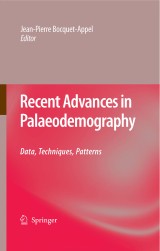Details

Recent Advances in Palaeodemography
Data, Techniques, Patterns|
96,29 € |
|
| Verlag: | Springer |
| Format: | |
| Veröffentl.: | 22.01.2008 |
| ISBN/EAN: | 9781402064241 |
| Sprache: | englisch |
| Anzahl Seiten: | 294 |
Dieses eBook enthält ein Wasserzeichen.
Beschreibungen
Jean-Pierre BOCQUET-APPEL CNRS, Paris, France The written data used by demographers essentially cover the last five centuries. Since Homo ergaster moved out of Africa around 1. 8 million years ago and until the sub-contemporary periods, there is no data allowing us to reconstruct a demographic history that can be interpreted with the traditional tools of demography. If we want to be able to tackle demographic issues over a long evolutionary duration, trying to reconstitute our human demographic history and thinking out and testing macro-demographic theories, we need to draw on sources other than written data and on techniques other than those commonly used by demographers. This necessarily means using inf- mation of every kind, from archaeology, physical anthropology, pale- tology, primatology or genetics, along with relevant models of interpretation. The volume presented here has been developed from a core of papers selected for the paleodemographic session of the 25th World Population Congress (July 2005, Tours, France), to which further requested contri- tions have been added. The publication covers recent paleodemographic innovations, in terms of data, techniques and the detection of patterns making it possible to highlight hitherto unknown prehistoric demographic processes. Now that the anxiety over ways of defusing the population “time bomb”, which mobilized mainstream demographic thinking as from the 1960s (see, for authority, Bogue and Tsui 1979; Demeny 1979) has largely been dis- pated, the focus has shifted to other important issues.
From Genes to Numbers: Effective Population Sizes in Human Evolution.- Assessment of Land Surveys in Greece: Contributions and Limitations.- Estimation of An Age Distribution With Its Confidence Intervals Using An Iterative Bayesian Procedure and A Bootstrap Sampling Approach.- Model Life Tables for Pre-Industrial Populations: First Application in Palaeodemography.- The Halley Band for Paleodemographic Mortality Analysis.- Modeling Paleolithic Predator-Prey Dynamics and the Effects of Hunting Pressure on Prey ‘Choice’.- The Demography of Prehistoric Fishing/Hunting People: A Case Study of the Upper Columbia Area.- The Paleodemography of Central Portugal and the Mesolithic-Neolithic Transition.- The Libben Site: a Hunting, Fishing, and Gathering Village from the Eastern Late Woodlands of North America. Analysis and Implications for Palaeodemography and Human Origins.- Demographic and Health Changes During the Transition to Agriculture in North America.
<P>The written data used by demographers essentially cover the last five centuries. Since <EM>Homo Ergaster</EM> moved out of Africa around 1.8 million years ago and until the sub-contemporary periods, there is no data allowing us to reconstruct a demographic history that can be interpreted with the traditional tools of demography. If we want to be able to tackle demographic issues over a long evolutionary duration, trying to reconstitute our human demographic history and thinking out and testing macro-demographic theories, we need to draw on sources other than written data and on techniques other than those commonly used by demographers. This necessarily means using information of every kind, from archaeology, physical anthropology, paleontology, primatology or genetics, along with relevant models of interpretation. </P>
<P>This book has been developed from a core of papers selected for the paleodemographic session of the 25th World Population Congress (July 2005, Tours, France). It covers recent paleodemographic innovations, in terms of data, techniques and the detection of patterns making it possible to highlight hitherto unknown prehistoric demographic processes.</P>
<P>This book has been developed from a core of papers selected for the paleodemographic session of the 25th World Population Congress (July 2005, Tours, France). It covers recent paleodemographic innovations, in terms of data, techniques and the detection of patterns making it possible to highlight hitherto unknown prehistoric demographic processes.</P>
Covers recent paleodemographic innovations, in terms of data, techniques and the detection of patterns
<P>Written data used by demographers essentially covers the last five centuries. To tackle earlier demographic issues, we need to draw on sources and techniques other than those commonly used by demographers. This means using information from archeology, physical anthropology, paleontology, primatology, and genetics, along with relevant models of interpretation. This book has been developed from a core of papers selected for the paleodemographic session of the 25th World Population Congress held in July 2005. It covers recent paleodemographic innovations in data, techniques, and the detection of patterns that make it possible to examine previously unknown prehistoric demographic processes. The book is fascinating reading for physical anthropologists, archeologists, bioarcheologists, demographers, and historical demographers.</P>

















